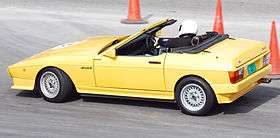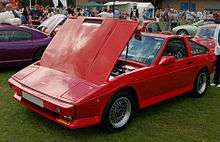TVR 350i
In 1982 TVR's then new owner Peter Wheeler found himself wanting more power than the Cologne V6-equipped Tasmin 280i could offer. Thus, based on the existing car the Tasmin 350i appeared in August 1983.[1] Using the same chassis and body (with some minor changes), a 3.5-litre Rover V8 was installed. After a year, the "Tasmin" part of the name was dropped and the car became plain TVR 350i.[2]
| TVR 350i | |
|---|---|
 | |
| Overview | |
| Manufacturer | TVR |
| Also called | TVR Tasmin 350i TVR 350SX |
| Production | 1983.08–1989 |
| Designer | Oliver Winterbottom |
| Body and chassis | |
| Class | Sports car |
| Body style | 2-dr coupé 2-dr convertible |
| Layout | FR layout |
| Platform | TVR Wedge |
| Related | TVR 390SE |
| Powertrain | |
| Engine | 3.5 L Rover V8 |
| Transmission | 5-spd MT |
| Chronology | |
| Predecessor | TVR Tasmin 280i |
Development
The 190 hp (142 kW) V8 propelled the 350i to 130 mph (209 km/h), while 60 mph came up in 6.3 seconds. The Rover-engined 350i provided the added benefit of being marketable in Arab countries, where there was a certain political resistance to buying Ford products because of Ford's close dealings with Israel.[2] The 350i also provided the basis for the 390SE first seen at the Birmingham Motor Show in October 1984,[1] as well as the extreme 420/450 SEAC and other future developments.

A modified form of the 350i's chassis, itself a stretched version of the chassis used for the old M-series, also underpinned the S-series as well as the later Griffith. There was a short run of non-factory Sprintex supercharged 350SX (and the bigger hearted 400SX) made by the Northern TVR Centre in the mid-1980s. Nine and two of the respective versions are thought to have been built. Power is not certain, but 260 bhp (194 kW) for the 350SX is commonly cited.[3]
By 1989, after the introduction of the 400/450SE and 420/450 SEAC, the lineup was rationalized and the by now least powerful 350i was dropped.[2] Over 1,000 350i's were built. The end of the run was marked by the limited edition (25 examples only) 3.9-litre TVR 350SE of 1990-91.
References
| Wikimedia Commons has media related to TVR 350. |
- James M. Flammang (1994). Standard Catalog of Imported Cars, 1946-1990. Iola, WI: Krause Publications, Inc. p. 619. ISBN 0-87341-158-7.
- Mike Lawrence (1991). A to Z of Sports Cars. Bideford, Devon: Bay View Books. p. 313. ISBN 1-870979-81-8.
- "TVR Wedge Specials". Pistonheads.com. Retrieved 14 December 2010.